|
 |
Hans Makart
|
|
(May 28, 1840 - October 3, 1884) was a 19th century Austrian academic history painter, designer, and decorator; most well known for his influence on Gustav Klimt and other Austrian artists, but in his own era considered an important artist himself and was a celebrity figure in the high culture of Vienna, attended with almost cult-like adulation.
Makart was the son of a chamberlain at the Mirabell Palace, born in the former residence of the prince-archbishops of Salzburg. Initially, he received his training in painting at the Vienna Academy between 1850 and 1851 from Johann Fischbach. While in the Academy, German art was under the rule of a classicism, which was entirely intellectual and academice clear and precise drawing, sculpturesque modelling, and pictorial erudition were esteemed above all. Makart, who was a poor draughtsman, but who had a passionate and sensual love of color, was impatient to escape the routine of art school drawing. For his fortune, he was found by his instructors to be devoid of all talent and forced to leave the Vienna Academy.
He went to Munich, and after two years of independent study attracted the attention of Karl Theodor von Piloty, under whose guidance, between 1861 and 1865 he developed his painting style. During these years, Makart also travelled to London, Paris and Rome to further his studies. The first picture he painted under Piloty, Lavoisier in Prison, though it was considered timid and conventional, attracted attention by its sense of color.
In his next work, The Knight and the Water Nymphs, he first displayed the decorative qualities to which he afterwards sacrificed everything else in his work. His fame became established in the next year, with two works, Modern Amoretti and The Plague in Florence. His painting Romeo and Juliet was soon after bought by the Austrian emperor for the Vienna Museum, and Makart was invited to come to Vienna by the aristocracy.
The prince Von Hohenlohe provided Makart with an old foundry at the Gusshausstraße 25 to use as a studio. He gradually turned it into an impressive place full of sculptures, flowers, musical instruments, requisites and jewellery that he used to create classical settings for his portraits, mainly of women. Eventually his studio looked like a salon and became a social meeting point in Vienna. Cosima Wagner described it as a "wonder of decorative beauty, a sublime lumber-room". His luxurious studio served as a model for a great many upper middle-class living rooms.
The opulent, semi-public spaces of the Makart atelier were the scene of a recurring rendezvous between the artist and his public. The artist became the mediator between different levels of society: he created a socially ambiguous sphere in which nobility and bourgeoisie could encounter one another in mutual veneration of the master, and aestheticized the burgeoning self-awareness of the bourgeoisie by means of historical models drawn from the world of the aristocracy. In this way, an artist like Makart lived out the image that high society had created of him. Makart is considered by many as being the first art star, referred to by contemporaries an "artist prince" (Malerferst) in the tradition of Rubens.
Makart became the acknowledged leader of the artistic life of the Vienna, which in the 1870s passed through a period of feverish activity, the chief results of which are the sumptuously decorated public buildings of the Ringstraße. He not only practised painting, but was also an interior designer, costume designer, furniture designer, and decorator, and his work decorated most of the public spaces of the era. His work engendered the term "Makartstil", or "Makart style", which completely characterized the era.
In 1879, Makart had designed a pageant organised to celebrate the Silver Wedding Anniversary of the Imperial couple, emperor Franz Josef and his wife Elisabeth of Bavaria he designed, single-handed, the costumes, scenic setting, and triumphal cars. This became known as the "Makart-parade", and had given the people of Vienna the chance to dress up in historical costumes and be transported back into the past for a few hours. At the head of the parade was a float for artists, led by Makart on a white horse. His festivals became an institution in Vienna which lasted up until the 1960s. In the same year as the first parade he became a Professor at the Vienna Academy.
Makart's painting The Entry of Charles V into Antwerp caused some controversy, because Charles V was depicted arriving in a procession surrounded by nude virgins; the offense was the mistaken idea that the nudes had no place in the modern scene. In the United States, the painting fell under the proscription of Anthony Comstock, which secured Makart's fame there. The American public desired at once to see what Comstock was persecuting, so they could tell whether he was acting correctly or in error.
Salzburg's Makart Square, or Makartplatz, was named after the painter.
|
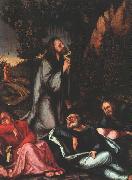 |
Hans Leonhard Schaeufelein
|
|
1480-1540
German
Hans Leonhard Schaeufelein Gallery
Hans Leonhard Schäufelein (c. 1480 ?C 1540) was a German painter, designer, and wood engraver.
He was born in Nuremberg, probably studied under Wohlgemut, and then became the assistant of Durer, whom he imitated. In 1512 he went to Augsburg and in 1515 removed to Nordlingen.
He is a graceful narrator, and his types, though rarely accurately drawn, are attractive, but he lacks power and depth. Characteristic early paintings are the altarpiece at Ober Sankt Veit, near Vienna (1502), "Scenes from the Life of Christ" (Dresden Gallery), and "St. Jerome" (Germanic Museum, Nuremberg).
To his Nordlingen period belong his masterpiece, the so-called "Ziegler Altar" for St. George's Church (1521), part of which is still in the church, part in the museum; "Scenes from the Story of Judith," in the town hall; and the illuminated Psalter for Count von Ottingen, now in the Berlin print room. His most important woodcuts are those for the Theuerdank of Emperor Maximilian.
Schäufelein created a playing card deck about 1535, which is regarded as a highlight in German 16th century playing card production. |
 |
Hans Knieper
|
|
painted Portrait of Frederick II of Denmark and Norway in 1581
|
 |
Hans Jordaens
|
|
(1555 - 1630), was a Flemish Baroque painter whose religious works are often confused with that of other painters with the same name.
|
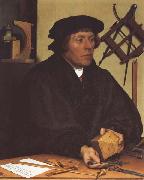 |
Hans holbein the younger
|
|
b. 1497, Augsburg, d. 1543, London
was a German artist and printmaker who worked in a Northern Renaissance style. He is best known as one of the greatest portraitists of the 16th century.[2] He also produced religious art, satire and Reformation propaganda, and made a significant contribution to the history of book design. He is called "the Younger" to distinguish him from his father, Hans Holbein the Elder, an accomplished painter of the Late Gothic school. Born in Augsburg, Holbein worked mainly in Basel as a young artist. At first he painted murals and religious works and designed for stained glass windows and printed books. He also painted the occasional portrait, making his international mark with portraits of the humanist Desiderius Erasmus of Rotterdam. When the Reformation reached Basel, Holbein worked for reformist clients while continuing to serve traditional religious patrons. His Late Gothic style was enriched by artistic trends in Italy, France, and the Netherlands, as well as by Renaissance Humanism. The result was a combined aesthetic uniquely his own. Holbein travelled to England in 1526 in search of work, with a recommendation from Erasmus. He was welcomed into the humanist circle of Thomas More, where he quickly built a high reputation. After returning to Basel for four years, he resumed his career in England in 1532. This time he worked for the twin founts of patronage, Anne Boleyn and Thomas Cromwell. By 1535, he was King's Painter to King Henry VIII. In this role, he produced not only portraits and festive decorations but designs for jewellery, plate, and other precious objects. His portraits of the royal family and nobles are a vivid record of a brilliant court in the momentous years when Henry was asserting his supremacy over the English church. Holbein's art was prized from early in his career. The French poet and reformer Nicholas Bourbon dubbed him "the Apelles of our time".[3] Holbein has also been described as a great "one-off" of art history, since he founded no school.[4] After his death, some of his work was lost, but much was collected, and by the 19th century, Holbein was recognised among the great portrait masters. Recent exhibitions have also highlighted his versatility. |
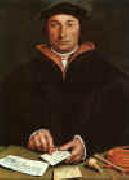 |
Hans Holbein
|
|
German
1497-1543
Hans Holbein Galleries
Holbein always made highly detailed pencil drawings of his portrait subjects, often supplemented with ink and colored chalk. The drawings emphasize facial detail and usually did not include the hands; clothing was only indicated schematically. The outlines of these drawings were then transferred onto the support for the final painting using tiny holes in the paper through which powdered charcoal was transmitted; in later years Holbein used a kind of carbon paper. The final paintings thus had the same scale as the original drawings. Although the drawings were made as studies for paintings, they stand on their own as independent, finely wrought works of art. How many portraits have been lost can be seen from Holbein's book (nearly all pages in the Royal Collection) containing preparatory drawings for portraits - of eighty-five drawings, only a handful have surviving Holbein paintings, though often copies have survived.
David Hockney has speculated in the Hockney-Falco thesis that Holbein used a concave mirror to project an image of the subject onto the drawing surface. The image was then traced. However this thesis has not met with general acceptance from art historians.
A subtle ability to render character may be noted in Holbein's work, as can be seen in his portraits of Thomas Cromwell, Desiderius Erasmus, and Henry VIII. The end results are convincing as definitive images of the subjects' appearance and personality. |
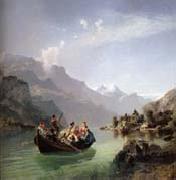 |
Hans Gude
|
|
March 13, 1825 ?C August 17, 1903,Norwegian painter. He was the most renowned Norwegian landscape painter of his time. At the age of 12 he was enrolled as a pupil of Johannes Flintoe (1787-1880). After attending evening classes at the Kongelige Tegneskole in Christiania, he went to D?sseldorf in 1841 to study privately with the landscape painter Andreas Achenbach (1815-1910). In 1842 Gude was admitted to the landscape class at the Akademie under Johann Wilhelm Schirmer. He was later appointed an assistant teacher at Schirmer private studio, and he succeeded his master as Professor of landscape painting both at the D?sseldorf Akademie (1854-62) and at the Karlsruhe Akademie (1864-80). In the 1840s Gude established his reputation in Norway and on the Continent with powerful images of the Norwegian mountains. These were shown in the Kunstforening galleries in D?sseldorf and Christiania and at the Berliner Akademische Kunstausstellung, where Gude exhibited throughout his life. Adolph Tidemand and Gude dominated the colony of Norwegian artists who studied in D?sseldorf in the mid-19th century. The two artists worked together on five paintings, all representing people in boats; Gude painted the landscape, Tidemand the figures. The Bridal Procession at Hardanger (1848; Oslo, N.G.) celebrates a ceremony of country life and is the most famous work of Norwegian National Romanticism. In a sunny western Norwegian landscape with snow on the high mountains, the bridal couple and wedding guests in national costume are shown rowing across the water from a medieval stave church on the headland in the background. Gude revealed greater maturity in High Mountain (1857; Oslo, N.G.). The disposition of mountains massed on the high plateau around a little lake produces an effect of monumentality. The predominant colours shade from grey to blue, concentrated in the cloud cover. The influence of Schirmer tranquil landscapes is apparent, while the rhythmic arrangement of light and shadow is reminiscent of Achenbach. |
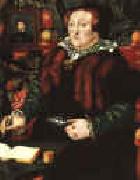 |
Hans Eworth
|
|
Flemish Northern Renaissance Painter, active 1540-1573
Flemish painter, active in England. Jan Euworts was listed in 1540 as a freeman of the Guild of St Luke in Antwerp, but by 1545 he had moved to England, where until 1571 his name, spelt in a wide variety of ways (e.g. Eeworts, Eottes, Euertz, Evance, Eworts, Ewotes, Ewout, Ewoutsz., Eywooddes, Hawarde, Heward, Huett etc), appeared in numerous naturalization, tax and parish documents. About 35 paintings are generally attributed to him, consisting primarily of dated portraits of the English gentry and nobility. The majority are signed with the monogram HE, which led to their being attributed to the Flemish painter Lucas de Heere during the 18th and 19th centuries. Cust reattributed the paintings to Eworth on the basis of an inventory (1590) of the collection of John, 1st Baron Lumley, in which three monogrammed portraits were listed as being by Haunce Eworth |
 |
Hans Cranach
|
|
(ca. 1513-1537), also known as Johann Lucas Cranach, was a German painter, the oldest son of Lucas Cranach the Elder. German art historian Christian Schuchardt, who discovered his existence, credits him with an altar-piece at Weimar, signed with the monogram "H. C.", and dated 1537. He died at Bologna in 1537. Luther mentions his death in his "Table Talk", and Johann Stigel, a contemporary poet, celebrates him as a painter.
|
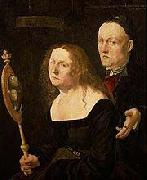 |
Hans Burgkmair
|
|
(1473 - 1531) was a German painter and printmaker in woodcut.
Burgkmair was born in Augsburg, the son of painter Thomas Burgkmair
and his son, Hans the Younger, became one too. From 1488 he was a pupil of Martin Schongauer in Colmar, who died during his two years there, before Burgkmair completed the normal period of training. He may have visited Italy at this time, and certainly did so in 1507, which greatly influenced his style. From 1491 he was working in Augsburg, where he became a master and opened his own workshop in 1498.
Hollstein ascribes 834 woodcuts to him, mostly for book illustrations, with slightly over a hundred being "single-leaf", that is prints not for books. The best of them show a talent for striking compositions, and a blend, not always fully successful, of Italian Renaissance forms and underlying German style. From about 1508 he spent much of his time working on the woodcut projects of Maximilian I until the Emperor's death in 1519. He was responsible for nearly half of the 135 prints in the Trumphs of Maximilian, which are large and full of character. He also did most of the illustrations for Weiss Kunig and much of Theurdank.
He was an important innovator of the chiaroscuro woodcut, and seems to have been the first to use a tone block, in a print of 1508.His Lovers Surprised by Death (1510) is the first chiaroscuro print to use three blocks.and also the first print that was designed to be printed only in colour, as the line block by itself would not make a satisfactory image. Other chiaroscuro prints from around this date by Baldung and Cranach had line blocks that could be and were printed by themselves.He produced one etching, Venus and Mercury (c1520),etched on a steel plate, but never tried engraving, despite his training with Schongauer. |
 |
Hans Bollongier
|
|
(1600-idem, 1645) was a Dutch Golden Age still life flower painter.
Bollongier was born in Haarlem. According to the RKD little is known of his early life. He became a member of the Haarlem Guild of St. Luke in 1623, and in 1675 his younger brother Horatio was named as his beneficiary. He was a specialist in bouquets of blooms. Paintings attributed to him that are not flower- or fruit still lifes are likely the work of his brother Horatio.He was an important influence on the later flower painters known as the monogrammist JF and Anthony Claesz II. He painted during a period of great productivity for Haarlem painters, during the decades after Karel van Mander published his Schilderboeck there. In Karel van Mander's book, there were a set of rules to follow to create good paintings and good drawings. Bollongier developed his own style and still observed all of these rules. His paintings were very popular, but his work was not regarded as such by contemporary Haarlem painters. As a genre, still life painting was considered inferior to historical allegories.
His work today is considered part of the proof that Tulip Mania took place, although there is reason to believe that this is also just part of early Haarlem tourist propaganda. Even as early as the 17th century, gentry from Amsterdam, Leiden, and places farther away enjoyed visiting the tulip fields of Haarlem in the Spring, and paintings of tulips were as popular as the bulbs.
|
 |
Hans Bol
|
|
(1534 - 1593), Flemish artist, received his early training from his two uncles who were also painters. He then was the apprentice to a Mechelen watercolorist and tempera painter at the age of fourteen. Because Boles watercolors became so widely reproduced, he began creating miniatures on parchment. The technique earned him many international clients and a good income. In addition, Bol also produced several oil paintings, illuminated manuscripts, drawings, and engravings. He preferred to create landscapes, mythological, allegorical and biblical scenes, and genre paintings.
Bol was a mannerist, which followed the High Renaissance.
One of his most famous works of art is Landscape with the Fall of Icarus, made with watercolours on paper. It was inspired by Ovid's Metamorphoses, in which the ancient myth of Icarus is told. The painting is a marvelous example of the art of landscape. Subtle colour transitions, skilful perspective and effective contrasts between foreground and background, and human figures and the forces of nature, lend this miniature painting a cosmic dimension.
Bol chose the Icarus theme on several occasions. It was also subject of one of his paintings, which described in detail and highly praised by Karel van Mander in the 17th century. Although Bol was once an important and admired painter, we only know him through his small drawings and watercolours. Most of his paintings appear to have been lost. This miniature is all the more important, because it probably produces the painting referret to by Van Mander, which may have been his masterpiece. Consequently, Bol ought to be viewed not only as a superior miniature painter, but above all as an important artist who played a key role in the development of landscape art.
|
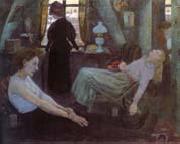 |
Hans Baluschek
|
|
German, 1870-1935,German illustrator, painter, and writer, known for his graphic depictions of the proletarian milieu and hard life in big cities. Baluschek was also a renowned illustrator of fairy tales and produced superb illustrations for five books in the series Deutsche Marchenbucherei published by the Klemm Verlag between 1878 and 1923: Peterchens Mondfahrt (Little Peter's Flight to the Moon, 1915), Pips der Pilz. Ein Wald?\ und Weihnachtsmarchen (Pips the Mushroom: A Forest and Christmas Fairy Tale, 1920), Prinzessin Huschewind (Princess Hush Wind, 1922), and Ins Marchenland (Into Fairyland, 1922). He employed aquarelles and oils to form unusual and bizarre characters and also used ink to create the text. |
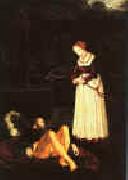 |
Hans Baldung Grien
|
|
German
1485-1545
Hans Baldung Grien Galleries
The earliest pictures assigned to him by some are altar-pieces with the monogram H. B. interlaced, and the date of 1496, in the monastery chapel of Lichtenthal near Baden-Baden. Another early work is a portrait of the emperor Maximilian, drawn in 1501 on a leaf of a sketch-book now in the print-room at Karlsruhe. "The Martyrdom of St Sebastian and the Epiphany" (Berlin Museum), fruits of his labour in 1507, were painted for the market-church of Halle in Saxony.
Baldung's prints, though D??reresque, are very individual in style, and often in subject. They show little direct Italian influence. His paintings are less important than his prints. He worked mainly in woodcut, although he made six engravings, one very fine. He joined in the fashion for chiaroscuro woodcuts, adding a tone block to a woodcut of 1510.[1] Most of his hundreds of woodcuts were commissioned for books, as was usual at the time; his "single-leaf" woodcuts (ie prints not for book illustration) are fewer than 100, though no two catalogues agree as to the exact number.
He was extremely interested in witches and made many images of them in different media, including several very beautiful drawings finished with bodycolour, which are more erotic than his treatments in other techniques.
Witch and Dragon. Drawing with bodycolour (b/w repro)Without absolute correctness as a draughtsman, his conception of human form is often very unpleasant, whilst a questionable taste is shown in ornament equally profuse and baroque. Nothing is more remarkable in his pictures than the pug-like shape of the faces, unless we except the coarseness of the extremities. No trace is apparent of any feeling for atmosphere or light and shade. Though Gr??n has been commonly called the Correggio of the north, his compositions are a curious medley of glaring and heterogeneous colours, in which pure black is contrasted with pale yellow, dirty grey, impure red and glowing green. Flesh is a mere glaze under which the features are indicated by lines. (1911)
His works are mainly interesting because of the wild and fantastic strength which some of them display. His Eve, the Serpent and Death (National Museum of Canada) shows his strengths well. We may pass lightly over the "Epiphany" of 1507, the "Crucifixion" of 1512, or the "Stoning of Stephen" of 1522, in the Berlin Museum. There is some force in the "Dance of Death" of 1517, in the museum of Basel, or the Madonna of 1530, in the Liechtenstein Gallery at Vienna. Gr??n's best effort is the altarpiece of Freiburg, where the Coronation of the Virgin, and the Twelve Apostles, the Annunciation, Visitation, Nativity and Flight into Egypt, and the Crucifixion, with portraits of donors, are executed with some of that fanciful power which Martin Schongauer bequeathed to the Swabian school.
As a portrait painter he is well known. He drew the likeness of Charles V, as well as that of Maximilian; and his bust of Margrave Philip in the Munich Gallery tells us that he was connected with the reigning family of Baden, as early as 1514. At a later period he had sittings from Margrave Christopher of Baden, Ottilia his wife, and all their children, and the picture containing these portraits is still in the grand-ducal gallery at Karlsruhe. Like D??rer and Cranach, Gr??n became a hearty supporter of the Reformation. He was present at the diet of Augsburg in 1518, and one of his woodcuts represents Luther under the protection of the Holy Ghost, which hovers over him in the shape of a dove. |
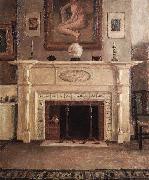 |
Hamilton Easter Field
|
|
(1873-1922) was an important American artist, teacher, author, critic, collector and patron of the arts |
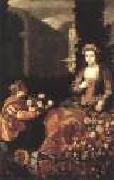 |
HAMEN, Juan van der
|
|
Spanish painter (b. 1596, Madrid, d. 1631, Madrid).
was a Spanish painter, a master of the still life paintings, also called bodegones. During his lifetime, he was prolific and versatile, painting allegories, landscapes, and large-scale works for churches and convents. However, today he is remembered mostly for his still lifes. In the 1620s, He popularized still life painting in Madrid. Juan van der Hamen y Leon was baptized on 8 April 1596 in Madrid, therefore, he must have been born there just days before that date. He was the son of Jehan van der Hamen, a Flemish courtier, who had moved to Madrid from Brussels before 1586, and Dorotea Whitman Gemez de Leon, a half-Flemish mother of noble Toledan ancestry . Van der Hamen and his two brothers Pedro and Lorenzo (both of whom were writers) emphasized their Spanish roots by using all or part of their maternal grandmother's family name, Gemez de Leon. The painter's father, Jan van der Hamen, had come to Spain, as an archer, to the court of Philip II were he settled, married, and his children were born. According to 18th-century sources, the artist's father had also been a painter, but there is no evidence for this. Juan van der Hamen inherited his father's honorary positions at court and also served as unsalaried painter of the king. Van der Hamen's artistic activity in the service of the crown is first recorded on 10 September 1619, when he was paid for painting a still-life for the country palace of El Pardo, to the north of Madrid. Noted for his versatility, Juan van der Hamen painted religious history paintings; allegories, landscapes, low-life subjects, portraits and still-lifes but the last two categories brought him the greatest fame. He served at the courts of Philip III and Philip IV and established the popularity of the new genre of still-life in Madrid in the 1620s. A prolific artist, van der Hamen painted all his works during the first decade of the reign of Philip IV. It is known that he painted more still lifes in 1622 than in any other period of his life. He also reached great personal fame as a portraitist, being this field, the one that provided him with greater personal success, since still life was considered a lesser genre. He executed a portrait of Philip IV and worked during the 1620s in a series of portraits of the principal intellectuals and writers of his time, including: Lope de Vega, Francisco de Quevedo, Luis de Gengora, Jose de Valdivieso, Juan Perez de Montalbon, Juan Ruiz de Alarcen and Francisco de Rioja. On van der Hamen's death, twenty of these portraits were inventoried as a single item among his belongings. The portrait of his older brother, Lorenzo van der Hamen, probably belonged to this series. The series itself was a focal point for philosophic speculation on the art of portraiture by some of the most distinguished minds of the time, who frequently praised Juan van der Hamen in verse and prose. Among Van der Hamen portraits, there is one of a dwarf, painted around 1623 in a powerful naturalistic style. This painting (Madrid, Museo del Prado) anticipated the later made by Velezquez. In 1626, van der Hamen painted cardinal Francesco Barberini, after a previous portrait by Velezquez had failed to please the sitter. Well satisfied with his work Cardinal Barberini acquired three further works from him. As a religious painter Juan van der Hamen worked for several religious institutions in and around Madrid and Toledo, like the Monastery of the Descalzas Reales, in Madrid, for which he painted altars. Few of these paintings are extant. The best surviving examples of his religious work are in the cloister of the Royal Convent of La Encarnacion in Madrid, painted in 1625 in a naturalistic tenebristic style. Juan van der Hamen was also a pioneer in the field of flower painting. Van der Hamen probably began painting floral arrangements in response to the flower pieces of Flemish artists, such as Jan Brueghel, who were regarded as exemplary masters in the field and whose works were much sought after in Spain. One good example of his work as a flower painter is his Offering to Flora , a visual poem that parallels the lyric verse of his time, in which he united his skills as portraitist and flower painter to produce one of the most beautiful paintings of the allegory of spring. |
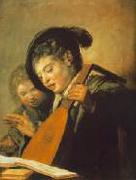 |
HALS, Frans
|
|
Dutch painter (b. 1580, Antwerpen, d. 1666, Haarlem). |
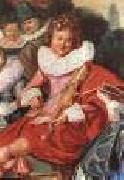 |
HALS, Dirck
|
|
Dutch painter (b. 1591, Haarlem, d. 1656, Haarlem).
Brother of Frans Hals. From 1618 to 1624 and again in 1640 he was an amateur of the Haarlem chamber of rhetoric known as De Wijngaertrancken, to which Frans also belonged. He was enrolled in the Guild of St Luke in Haarlem from 1627 to his death. As Blade has established on stylistic grounds, Dirck collaborated with the architectural painter Dirck van Delen from that year until 1634, with Hals painting the figures. On 4 April 1634 a lottery of paintings was announced, organized by Dirck Hals (who sent some of his own pictures) and Cornelis van Kittensteijn in the inn De Basterdpijp in Haarlem. The following year, on 20 June 1635, the notary van Leeuwen at Leiden authorized Dirck Hals to collect moneys for Pieter Jansz. van den Bosch of Leiden in connection with the proceeds of paintings sold at Haarlem. On 2 March 1643 Dirck Hals signed as a witness in the presence of the notary Willem van Vredenburch at Leiden. |
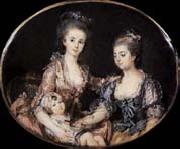 |
HALL, Peter Adolf
|
|
1739-1793
Swedish painter and collector. In 1753 he attended Uppsala Universitet to study medicine and natural history. In 1755 he went on a study trip abroad, led by his drawing-master Lars Brisman. While in Germany (1756-9) he studied miniature painting with Eichhardt in Berlin and with Karl Friedrich Wilhelm Richard (1725-70) in Hamburg. After this trip, he decided to become a professional portrait painter, and in 1759 he enrolled at the Kungliga Akademi for de Fria Konsterna in Stockholm, studying drawing with the French sculptor Pierre-Hubert Larchaveque (1721-78) and painting with Gustaf Lundberg. He attracted the attention of C. F. Adelcrantz, who in 1766 gained for him a commission for the pastel portrait of Princes Karl and Fredrik Adolf. In that year he also executed a miniature portrait of Crown Prince Gustav on the occasion of his engagement to Princess Sophia Magdalena of Denmark. Also in 1766 he received a royal travel grant to study in Paris, where he developed a completely new technique of miniature painting using sweeping brushwork and a clear and fresh range of colour that allowed for lively characterization. He made exquisite detailed studies of the backgrounds of his paintings, as well as his sitters costumes and their attributes and accessories. His new technique involved applying gouache to the ivory in a manner that allowed the ivory to show through, a method that was particularly successful in depicting drapery. The smooth surface of the ivory also allowed freer brushwork associated with full-scale portraits. |
 |
Haberle John
|
|
American Painter, 1856-1933
was a 19th century American painter in the trompe l'oeil (literally, "fool the eye") style. His still lifes of ordinary objects are painted in such a way that the painting can be mistaken for the objects themselves. He is considered one of the three major figures??together with William Harnett and John F. Peto??practicing this form of still life painting in the United States in the last quarter of the 19th century. A Bachelor's Drawer by John Haberle, 1890?C94, oil on canvas, 50.8 x 91.4 cm, Metropolitan Museum of Art, New YorkHaberle was born in New Haven, Connecticut; his parents were Swiss immigrants. At the age of 14 he left school to apprentice with an engraver. He also worked for many years as an exhibit preparator for the Peabody Museum of Natural History at Yale University. His career as a painter began in 1887. His style is characterized by a meticulous rendering of two-dimensional objects. He is especially noted for his depictions of paper objects, including currency. Art historian Alfred Frankenstein has contrasted Haberle's work with that of his contemporaries: Peto is moved by the pathos of used-up things. Haberle is wry and wacky, full of bravado, self-congratulating virtuosity, and sly flamboyance. He works largely within an old tradition, that of the trompe l'oeil still life in painted line ... It is poles away from Harnett's sumptuosity, careful balances, and well-modeled volumes, and is equally far from Peto's sensitivity in matters of tone and hue. |
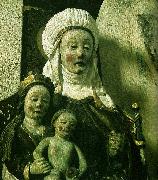 |
haaken gullesons
|
|
Ytterlännäs parish, in the province of Ångermanland, belonged to the Archdiocese of Uppsala in the Middle Ages, but has been part of the Diocese of Härnösand since that was formed in 1647. The two churches of he parish, the old one from the early 13th century, and the new one from 1848-1854, are located between the communities of Nyland and Bollstabruk, within Kramfors Municipality.
The Ytterlännäs New Church taken into use in 1854 is an example of the style known as a tegnarlada ("Tegnor barn") - spacious, white, clean, neo-classical. The Ytterlännäs Old Church (Ytterlännäs Gamla Kyrka) dates from the 1200s and features medieval vaults, wall-paintings and wooden sculptures, and baroque furnishings including the unusual feature of two galleries; the Ytterlännäs Madonna is regarded by experts as a particularly fine example of the work from the Hälsingland workshop of Haaken Gulleson, all in an excellent state of preservation thanks to the church's being abandoned after 1854. |
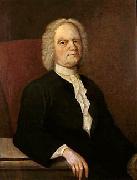 |
Gustavus Hesselius
|
|
(1682 - May 25, 1755) was a Swedish born painter who emigrated to the New World in 1711. He was the father of painter John Hesselius and cousin of the religious leader Emanuel Swedenborg.
Hesselius left his home country of Sweden for Wilmington, Delaware in 1711. There he lived until 1717 when he moved to Philadelphia, Pennsylvania, where he lived until 1721. In 1721, he moved to Prince George's County, Maryland and became a portrait painter, though he had been trained in Sweden. That same year, he received the first recorded public art commission in the American colonies, he painted The Last Supper. He also painted a Crucifixion. Some time around 1735, Hesselius returned to Philadelphia where spent the rest of his life and traveling. He was listed as a member of the Gloria Dei (Old Swedes') Church in Philadelphia.
He also worked as an organ builder, having built an organ for the Moravian Church in Bethlehem, Pennsylvania in 1746. From about this time on, he focused on building organs, referring painting commissions to his son John.
J. Hall Pleasants has said that Hesselius became "America's earliest portrait painter of note." In 1994 he was named to the Prince George's County Hall of Fame.
|
 |
Gustav Adolph Hennig
|
|
Gustav Adolph Hennig (1797-1869)Professions: Historical-scenes painter; Porträtmaler; Miniature painter; Etcher; Lithographer. |
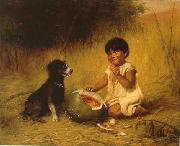 |
Grace Hudson
|
|
(1865 - 1937) was an American painter. She was nationally known during her lifetime for a numbered series of more than 684 portraits of the local Pomo Indians. She painted the first, "National Thorn", after her marriage in 1891, and the last in 1935.
Grace Carpenter was born in Potter Valley, California. Her mother was one of the first white school teachers educating Pomo children and was a commercial portrait photographer in Ukiah, California; her father was a skilled panoramic and landscape photographer who chronicled early Mendocino County frontier enterprises such as logging, shipping and railroading. At fourteen years of age, Grace was sent to attend the recently-established San Francisco School of Design, an art school which emphasized painting from nature rather than from memory or by copying existing works. At sixteen, she executed an award-winning, full length, life sized self-portrait in crayon. While in San Francisco, she met and eloped with a man fifteen years her senior named William Davis, upsetting her parents and ending her formal studies. The marriage lasted only a year.
From 1885 to 1890, Grace Carpenter Davis lived with her parents in Ukiah painting, teaching and rendering illustrations for magazines such as Cosmopolitan and Overland Monthly. Her work at that time had no particular focus and included genre, landscapes, portraits and still lifes in all media. Later in her career she would continue to accept occasional magazine illustration assignments including ones for Sunset.
|
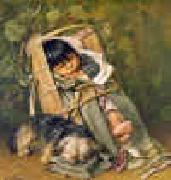 |
Grace Carpenter Hudson
|
|
1865-1937
Grace Carpenter Hudson Galleries
Grace Carpenter Hudson (1865 - 1937) was an American painter. She was nationally known during her lifetime for a numbered series of more than 684 portraits of the local Pomo Indians. She painted the first, "National Thorn", after her marriage in 1891, and the last in 1935.
Grace Carpenter was born in Potter Valley, California. Her mother was one of the first white school teachers educating Pomo children and was a commercial portrait photographer in Ukiah, California; her father was a skilled panoramic and landscape photographer who chronicled early Mendocino County frontier enterprises such as logging, shipping and railroading.[1] At fourteen years of age, Grace was sent to attend the recently-established San Francisco School of Design, an art school which emphasized painting from nature rather than from memory or by copying existing works. At sixteen, she executed an award-winning, full length, life sized self-portrait in crayon. While in San Francisco, she met and eloped with a man fifteen years her senior named William Davis, upsetting her parents and ending her formal studies. The marriage lasted only a year.
From 1885 to 1890, Grace Carpenter Davis lived with her parents in Ukiah painting, teaching and rendering illustrations for magazines such as Cosmopolitan and Overland Monthly. Her work at that time had no particular focus and included genre, landscapes, portraits and still lifes in all media. Later in her career she would continue to accept occasional magazine illustration assignments including ones for Sunset. |
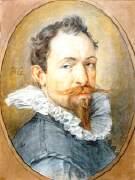 |
GOLTZIUS, Hendrick
|
|
Dutch Baroque Era Painter and Engraver, 1558-1617
Dutch draughtsman, printmaker, print publisher and painter. He was an important artist of the transitional period between the late 16th century and the early 17th, when the conception of art in the northern Netherlands was gradually changing. Goltzius was initially an exponent of Mannerism, with its strong idealization of subject and form. Together with the other two well-known Dutch Mannerists, Karel van Mander I and Cornelis Cornelisz. van Haarlem, he introduced the complex compositional schemes and exaggeratedly contorted figures of Bartholom?us Spranger to the northern Netherlands. These three artists are also supposed to have established an academy in Haarlem in the mid-1580s, but virtually nothing is known about this project. In 1590 Goltzius travelled to Italy, thereafter abandoning Spranger as a model and developing a late Renaissance style based on a broadly academic and classicizing approach. Later still, his art reflected the growing interest in naturalism that emerged in the northern Netherlands from c. 1600. |
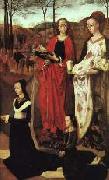 |
GOES, Hugo van der
|
|
Netherlandish Northern Renaissance Painter, ca.1440-1482
South Netherlandish painter. In 1467 he enrolled as master in the Ghent painters' guild, sponsored by Joos van Wassenhove, master painter in Ghent in 1464 after registering in Antwerp in 1460. In 1469 the two together acted as guarantors for the illuminator Sanders Bening when he became a master, and it was from Hugo that Joos borrowed money when he went to Rome. Sanders Bening was married to Kathelijn van der Goes, perhaps Hugo's sister. Hugo's status within the guild is further attested by the fact that he was guarantor for two other painters in 1471 and 1475, that he was one of the dean's jurors in 1468-9 and that he himself served as dean from towards the end of 1473-4 to at least 18 August 1475. |
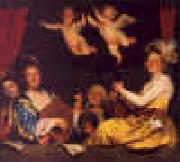 |
Gerrit van Honthorst
|
|
1590-1656
Dutch
Gerrit Van Honthorst Galleries
Gerard van Honthorst (November 4, 1592 - April 27, 1656), also known as Gerrit van Honthorst and Gherardo della Notte, was a Dutch painter of Utrecht. He was brought up at the school of Abraham Bloemaert, who exchanged the style of the Franckens for that of the pseudo-Italians at the beginning of the 16th century.
Margareta Maria de Roodere and Her Parents by Gerrit van Honthorst (1652) Oil on canvas, 140 x 170 cm. Centraal Museum, UtrechtInfected thus early with a mania which came to be very general in the Netherlands, Honthorst went to Italy in 1616, where he copied the naturalism and eccentricities of Michelangelo da Caravaggio. Home again about 1620, after acquiring a considerable practice in Rome, he set up a school at Utrecht which flourished exceedingly. Together with his colleague Hendrick ter Brugghen, he represented the so-called Dutch Caravaggisti. In 1623 he was president of his gild at Utrecht, where he had married his cousin. He soon became so fashionable that Sir Dudley Carleton, then English envoy at The Hague, recommended his works to the earl of Arundel and Lord Dorchester. In 1626 he received a visit from Rubens, whom he painted as the honest man sought for and found by Diogenes.
The queen of Bohemia, sister of Charles I of England and electress palatine, being in exile in the Netherlands, gave Honthorst her countenance and asked him to teach her children drawing; and Honthorst, thus approved and courted, became known to her brother Charles I, who invited him to England in 1628. There he painted several portraits, and a vast allegory, now at Hampton Court, of Charles and his queen as Diana and Apollo in the clouds receiving the duke of Buckingham as Mercury and guardian of the king of Bohemia's children. Charles I, whose taste was flattered alike by the energy of Rubens and the elegance of Van Dyck, was thus first captivated by the fanciful mediocrity of Honthorst, who though a poor executant had luckily for himself caught, as Lord Arundel said, much of the manner of Caravaggio's colouring, then so much esteemed at Rome. |
 |
Gerard van Honthorst
|
|
(November 4, 1592 - April 27, 1656), also known as Gerrit van Honthorst and Gherardo della Notte, was a Dutch painter of Utrecht. He was brought up at the school of Abraham Bloemaert, who exchanged the style of the Franckens for that of the pseudo-Italians at the beginning of the 16th century.
Margareta Maria de Roodere and Her Parents by Gerrit van Honthorst (1652) Oil on canvas, 140 x 170 cm. Centraal Museum, UtrechtInfected thus early with a mania which came to be very general in the Netherlands, Honthorst went to Italy in 1616, where he copied the naturalism and eccentricities of Michelangelo da Caravaggio. Home again about 1620, after acquiring a considerable practice in Rome, he set up a school at Utrecht which flourished exceedingly. Together with his colleague Hendrick ter Brugghen, he represented the so-called Dutch Caravaggisti. In 1623 he was president of his gild at Utrecht, where he had married his cousin. He soon became so fashionable that Sir Dudley Carleton, then English envoy at The Hague, recommended his works to the earl of Arundel and Lord Dorchester. In 1626 he received a visit from Rubens, whom he painted as the honest man sought for and found by Diogenes. |
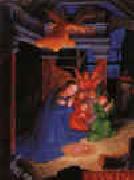 |
Gerard Hornebout
|
|
Flemish Northern Renaissance Painter and Manuscript Illuminator, ca.1465-1541 |
 |
Gerard Hoet
|
|
(1648 - 1733), was a Dutch Golden Age painter.
Gerard Hoet trained with his father and brother who were glass painters, and Warnard van Rijsen, who lived in Zaltbommel, and who himself was a pupil of Cornelis van Poelenburgh in Utrecht. In 1672 Hoet moved to The Hague, but when the Count of Salis bought paintings at his mother's house in Zaltbommel, he returned to paint for him. He accompanied him to Rees, Germany, where he met the Utrecht painters Jan van Bunnik, Justus Nieuwpoort and Andries de Wit.With De Wit he returned to Utrecht, where he worked for Frederick Nassau de Zuylestein briefly before visiting the Hague and Amsterdam. He then travelled to France on the promise of a Marquis who wanted to give him a commission, but this promise falling through, he made some engravings of paintings by Francisque Millet.He then wanted to travel to England, but having written to his compatriot Lucas Vorsterman, he received word that there was more work to be had in Paris. Hoet travelled to Paris where he spent more than a year, before returning to the Netherlands via Brussels.In Brussels he met the painter Adriaen Frans Boudewyns, who convinced him to stay a while. After eight months, Hoet returned to Utrecht, where he worked for William Nassau de Zuylestein, 1st Earl of Rochford. He married and settled in Heemstede (Utrecht), where he found work for the lord of the castle there |
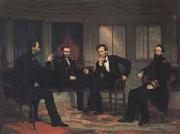 |
George P.A.Healy
|
|
American Painter, 1813-1894
American painter, active also in Europe. At the age of 17 he set up a studio in Boston after receiving encouragement from Thomas Sully, who was painting portraits there. Despite his youth and lack of training, he presented himself to the society figure Mrs Harrison Gray Otis and asked if he might paint her portrait (untraced); she agreed and later sponsored Healy's first trip abroad. In 1834 he entered the studio of Antoine-Jean Gros; the French master's suicide the following year ended Healy's only sustained period of artistic study. In Gros's studio he first encountered Thomas Couture, but they did not meet again until the next decade |
|

